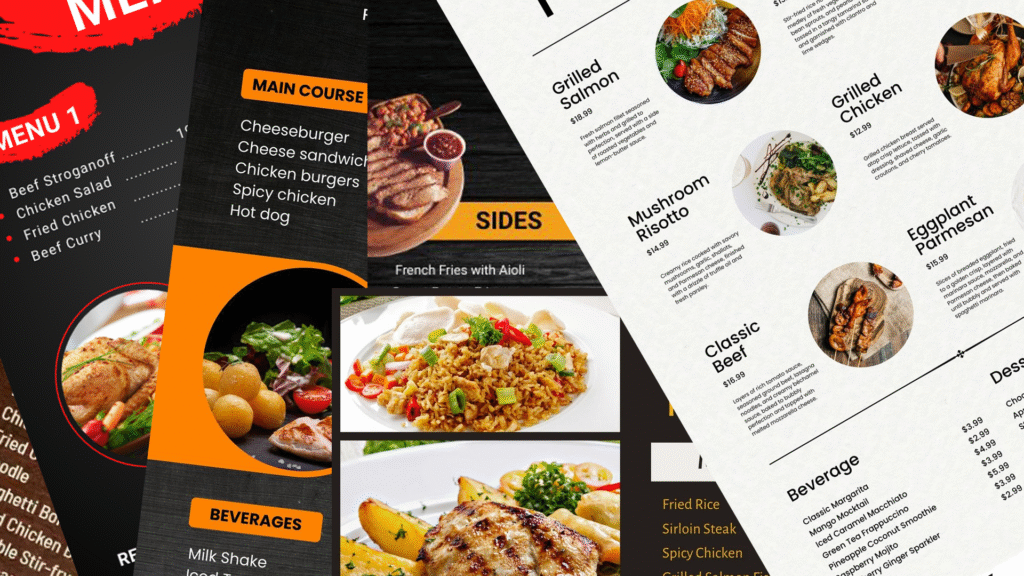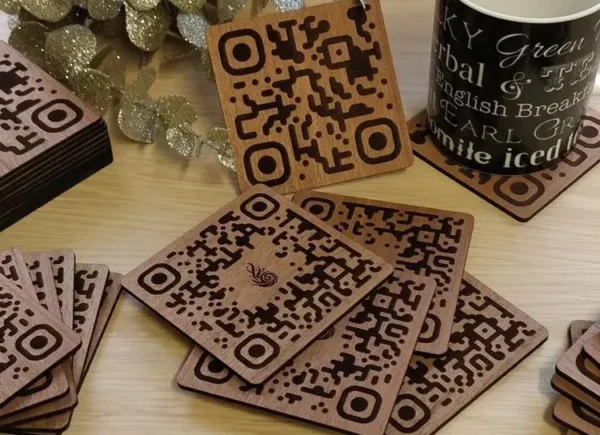We are excited to be the first to offer local food menus to our viewers. Which also means that the restaurants and coffee shops get upgraded menus. As simple or as fancy as they want their menus to be.
There are so many platforms for menus, as a restaurant customer, we know what ever is available and easy for you, that is what counts.
However, if you are a restaurant owner or have been to some tech-savvy restaurants you have already seen the Tablet menus, QR menus, Traditional printed menus, “look up” screen/display menus, table side Touch-screen digital menu, website HTML menu, online PDF menu, TV Screen menu, and so on and so forth!. They are all great… but then they all have their challenges and limitations (since we know there’s nothing perfect, we pick what has the least imperfections, and such is life).
Ultimately as a restaurant owner, you have to choose based on several factors the one that will best work for you… wait, and then, there’s also the TALABAT, and the likes which are also nice but with their own challenges or limitations. We only include them here because they have menus AND for the benefit of restaurants that do not have website to understand our services.
By the way, we leave alone the “special of the day” menus that are typically hand written on some type of a board. Those we understand are restricted to certain locations. Sort of like a big department store may have a sale at one location and not at the other.
Let’s explore the existing menus’ pros & cons to start with, so that if you are an existing restaurant owner or an aspiring restaurant owner, you can choose what is best for you. As a matter of fact if you already have used some kind of a menu or another, you probably have more insights to share than we have highlighted here (both the pros and the cons).
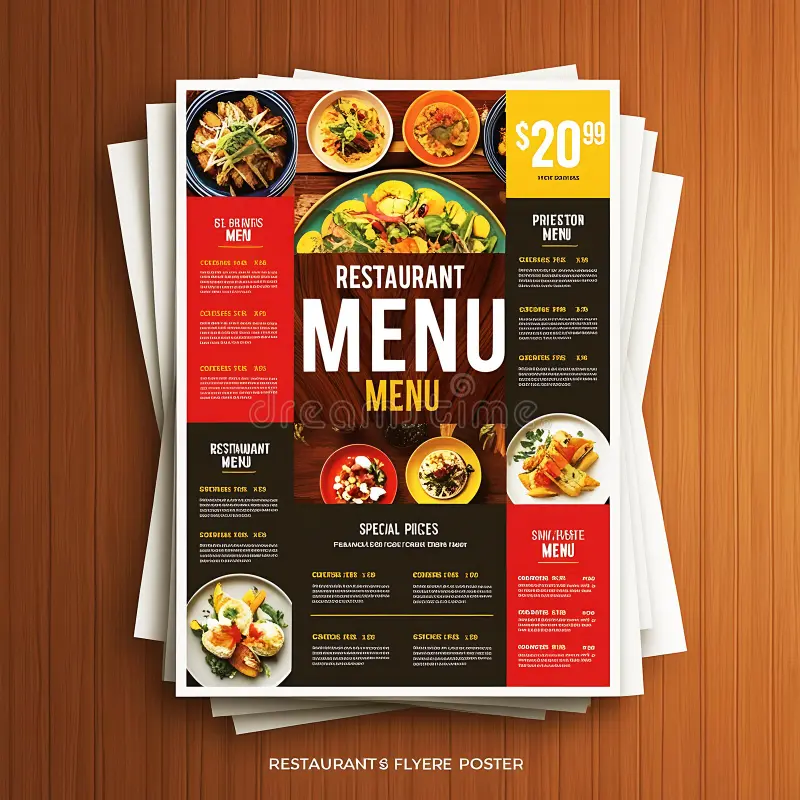
Courtesy: dreamstime.com/restaurant-food-menu-poster-design-template-image346673070
- The Printed Menu
- The PROS
- With regards to the Printed Menu, we know how great they are, they have lasted many decades without complications;
- easy to handle for the customer
- can be easily placed on every table
- can be laminated and even used as table mats
- can represent actual images of foods and ingredients and make it easy for the customer to order what they want.
- and a few more positives… maybe not in our mind as we write this
- With regards to the Printed Menu, we know how great they are, they have lasted many decades without complications;
- The CONS
- The problems or CONS arising from using the Printed Menu are almost as big as the PROS list, if not bigger.
- Most often they do not have images of ALL food items offered
- Most often they lack descriptions or ingredients making it hard for customers to choose (especially vegans), or people with certain restrictions, allergies, etc., they do not know what to order without talking to the waiter and enquiring… that too it would be great if the waiter was fully aware of this issue to handle it.
- Many times not all items can be ordered because of change of Chef or unavailability of ingredients out of season. This is not updated on the menu.
- When there’s a new Chef, part of the menu must be updated, this cab be pretty expensive for restaurants.
- The menus tear or get scratched or get to become unreadable after a few months of use and must be reprinted, again raising cost for the restaurants.
- There can be a worry about the hygiene of handling them if the client does not see them cleaned often.
- When restaurant owners want to update prices or their menu with new items, adding items as they go, it is quite expensive even in countries where it is considered to be cheap.
- The problems or CONS arising from using the Printed Menu are almost as big as the PROS list, if not bigger.
- The PROS
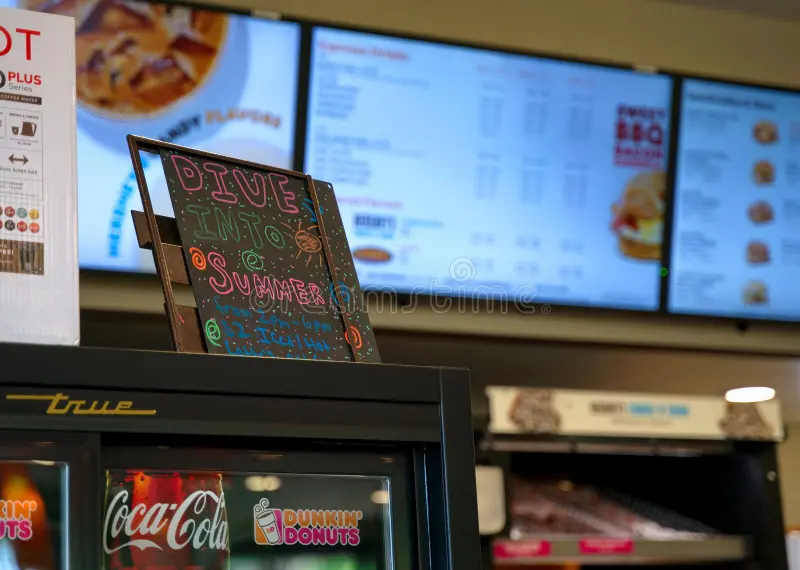
Courtesy: thumbs.dreamstime.com/b/summer-promo-board-restaurant-cromwell-ct-usa-jul-welcoming-sign-fun-ahead-local-dunkin-donuts-illustrative-editorial-161101507.jpg
- The Look Up Screen Menu
- The PROS
- These types of menus are typically found at global fast-food restaurants (like McDonald’s, Hardee’s, etc.)or those that try to match them.
- They are easy to look at
- They represent most of the foods with images
- They can easily be updated
- Most hygienic, as there are no worries about touching them
- They are great for chain restaurants, because all prices and products can be modified at once (overnight) via the internet.
- These types of menus are typically found at global fast-food restaurants (like McDonald’s, Hardee’s, etc.)or those that try to match them.
- The CONS
- The CONS for these types of menus exist and may be worse than those of the Printed Menus
- Some people use programs like power point and as such these menus can only be updated if the user has time to create a new menu… since most do this from home, the updates are slow.
- For those who use paid over the internet programming, especially in case of chain restaurants, a small mistake can cause a lot of problems. For example if the price is high, customers may walk out without even raising their concern. If the price is low, it is low in all branches and the establishments loose money.
- They are sometimes hard to read (for some aging folks),
- Many times there are too many items to put on the screen, and one finds themselves looking left and right, as items disappear and reappear on different screens… this can be frustrating especially if you walk into such an establishment as a group!
- While the programming can be fast, if there’s an issue with the internet, updates cannot happen where there are connectivity issues.
- If programming is outsourced, there’s issue of availability of staff to handle the updates, especially when timing is very different between host country and outsourced country.
- When the screens burn out (about every 20,000 hours) or the power supplies burn out (quite often). Some screens do not display!
- The biggest issue here is the actual cost… it is much higher (sort of prohibitive for many small restaurants) much more than the Printed Menus, with the best positive point being the flexibility to update.
- The CONS for these types of menus exist and may be worse than those of the Printed Menus
- The PROS
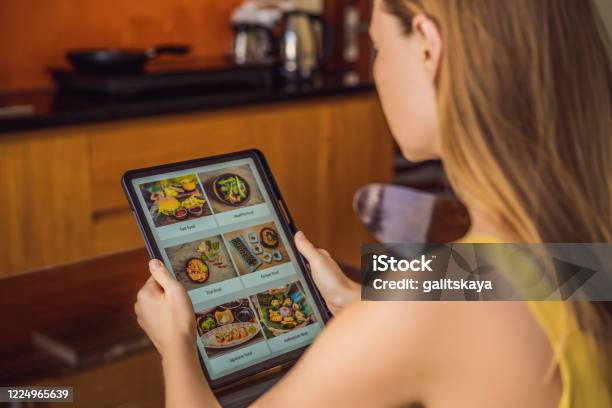
Courtesy: media.istockphoto.com/id/1224965639
- The Tablet Menu
- The PROS
- These are the coolest when you see them, and many small chain restaurants opt for them over the Look Up Screen Menus.
- They can be put on every table easily
- They can be updated (in most cases in house) overnight
- They can be well organized with items appearing in multiple places… for example an item can be under Vegan page, as well as appetizer, or desert, or main course
- Each menu item can have a unique image
- Each menu item can be clicked to reveal more information such as portion size, ingredients, preparation methods, and/or options.
- Videos can be added to some menu items to represent them even better
- These are the coolest when you see them, and many small chain restaurants opt for them over the Look Up Screen Menus.
- The CONS
- Yes we know that even if you have not handled a tablet menu yet, you already know there are plenty of problems
- First is the learning curve! There is no standard format, and as much as the programmers try to create a great product, there are many at the table who struggle to understand the programmers thought process
- As easy as it should be, it is actually complicated to find what you want; the Printed Menu always wins over this due to its simplicity.
- You may have been at a restaurant where your tablet suddenly died… and you got the “I’m sorry, sir/madam, I’ll get you one with a good charge”. You just have to start over again
- Yes so they are a head ache for employess as they have to be charged every night, and a busy place needs many of these babies, as they won’t have enough time to charge them.
- Goes without saying, they are VERY expensive compared to the Printed Menu and if a restaurant has many tables and offers more than one per table, the cost can be prohibitive.
- They are fragile and can break or malfunction
- The cost of replacement is WAY over that of the Printed Menu
- Some customers may be worried more about the hygiene of these items than the Printed or the Look Up Screen menus.
- Yes we know that even if you have not handled a tablet menu yet, you already know there are plenty of problems
- The PROS

Courtesy: media.istockphoto.com/id/1303502055
- The QR Code Menu
- The PROS
- In todays world these are probably the best type of menus
- Most clients carry smartphones that they can use to scan the QR to access the menu
- The menu can be as elaborate as you want it to be
- Like the tablet menu, you can organize it any way you want
- There’s no investment in any digital devices (like in the case of tablets), since each customer uses his/her own, and many prefer it that way.
- QR codes (stickers) are cheap and can be placed almost anywhere you can imagine. On the tables (as stickers), or at the door, at the counter, on tissue boxes, big screen TV’s, etc.
- Dynamic QR codes can be pointed to different places and are great when the menus need to be updated.
- In todays world these are probably the best type of menus
- The CONS
- For most part there are very few negatives if any for the QR Code Menu
- To be able to read QR codes, it requires one to have a phone or a tablet with software to read QR codes. Luckily most of the phones today can do that, and for those which cannot, one can download free software to be able to accomplish this task.
- Second and probably the major issue is that one has to not only whip out their phone and turn it on, they also have to either activate the QR code reading program or turn on their default camera app (if it has pre-built software) and aim it to the QR code and wait until it actually reads the code, then it goes online to find the link.
- From the previous point, it is clear that the customer must have access to WiFi to get on internet. Good thing is that today in the Gulf even the least paid person has a phone with active data. If not, the restaurant “may” provide free access to internet.
- In most cases QR Codes are printed on paper or sticker, and some times put in a table tent or under glass of the table top. In most cases, they need to be replaced often.
- For most part there are very few negatives if any for the QR Code Menu
- The PROS
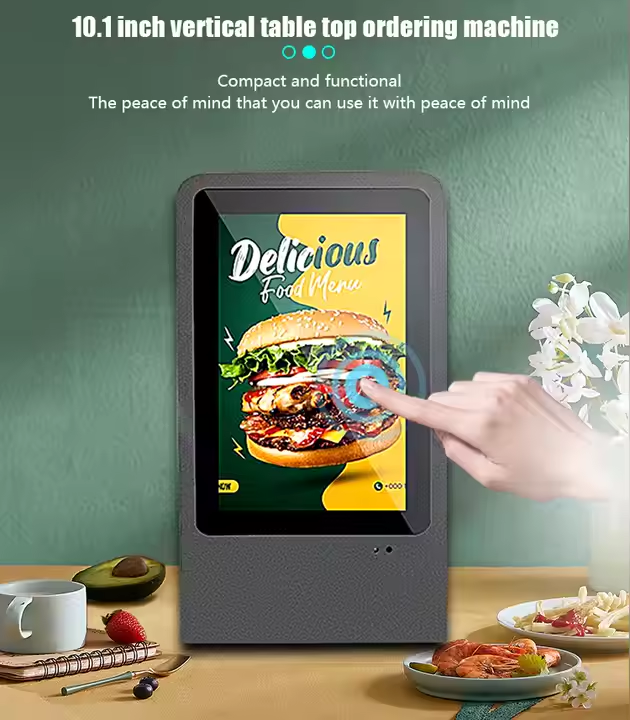
Courtesy: Alibaba
- Table Side Touchscreen Digital Menu
- The Pros
- These menus are fantastic and can offer quite some flexibility making them even better than Tablet Menus
- They are hardy, which means they perform well for a long time
- They are connected to the wall or fixed at a table point, which means they are always charged and good to go
- They are normally easy to read from all angles
- Most often they are directly linked to the ordering system, and the kitchen, which means there is no need to wait for the waiter to place your order
- Given that they are fixed, children cannot drop them down accidentally, and parents can order for their children
- Most can be centrally updated, which means the menus can be updated online quickly
- These menus are fantastic and can offer quite some flexibility making them even better than Tablet Menus
- The Cons
- Unfortunately they too have some drawbacks
- They are fine as long as there’s only one person or a couple at the table, if there are more than 2 people, they are difficult to work with based on practicality
- They are expensive to invest in as a starter for most restaurants
- Normally they require non-standard software to update, which may present a big learning curve
- Normally they are sold by a company, which means when something goes wrong you need support which may or may not be available at the critical time you need support
- Unless customers see them being cleaned, they are presumed dirty to touch and hazardous to health especially during times when diseases break out
- Normally when you are ready to update them or order more, they are no longer in production, so you need to replace all (due to required software) or work with two or three different software, which becomes cumbersome.
- Unfortunately they too have some drawbacks
- The Pros

Talabat and similar style services should not even be on this list, as this list mainly deals with menu’s in the restaurants. As stated before, we only include them here because they have menus AND for the benefit of restaurants that do not have website to understand our services.
- Talabat & The Likes
- The Pros
- Talabat and similar platforms are just fantastic. They offer so much for people who love to shop online.
- Customers have access to a very large selection of menus from multiple restaurants
- A family can order from multiple restaurants and have every person happy eating what they desire, that is a dream in itself. Every mom wish she had a kitchen that will bring out food that every single person is happy with
- Of course without saying delivery to home, office, farm, beach or wherever you are. You cannot beat that
- There are often deals and rewards for ordering through the system, and many smart families calculate and accordingly take advantage of the offers, which beats going to eat at the actual restaurant
- Ordered food can still be eaten at the family table
- Last minute party is totally possible
- The system is detailed in letting you know every aspect of the order processing up until delivery.
- Normally the food arrives hot AND you can track the delivery person and accordingly get things or everyone ready for the meal.
- Talabat and similar platforms are just fantastic. They offer so much for people who love to shop online.
- The Cons
- Yes unfortunately there are a few no so pleasant things
- Some times the orders take too long and the food is cold
- There are many cases where one delivery person picks more than one delivery and you can see while you are tracking them, they are at someone’s waiting for a while before they finally leave to come to you (that can be super irritating)
- You do not always get a choice of where your food comes from in case of chain restaurants. You may love the way a certain dish is prepared at location A, but you may receive the same dish prepared from location B, and there is a significant difference.
- Since the sellers/restaurants can turn on and off their availability, some times your favorite place may not be available (especially if they are busy at the restaurant)
- The menus don’t match, the actual restaurant menu always has more things which they do not add to the public menu either because they make no profit due to fees levied, or the delivery time may cause the items may not arrive in the same state as they would be when served at the restaurant.
- Yes unfortunately there are a few no so pleasant things
- The Pros
What do we have on the plate?
Well, we have a system that offers many of the above including online html menu, online pdf menu (which can be downloaded an printed as needed), QR Code menu (links to online html or pdf menu, ours or yours), and the newest NFC menu programmed to link to html or pdf menu, ours or yours.
To start with, we will talk about the new NFC menus, if you have questions about other menus, please use the contact form to get in touch with us.
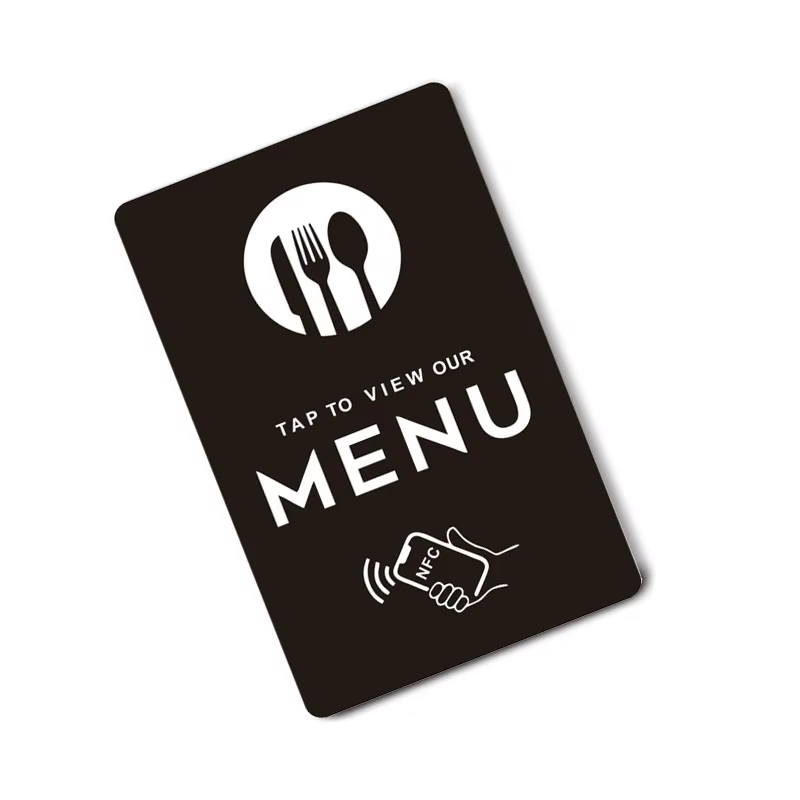
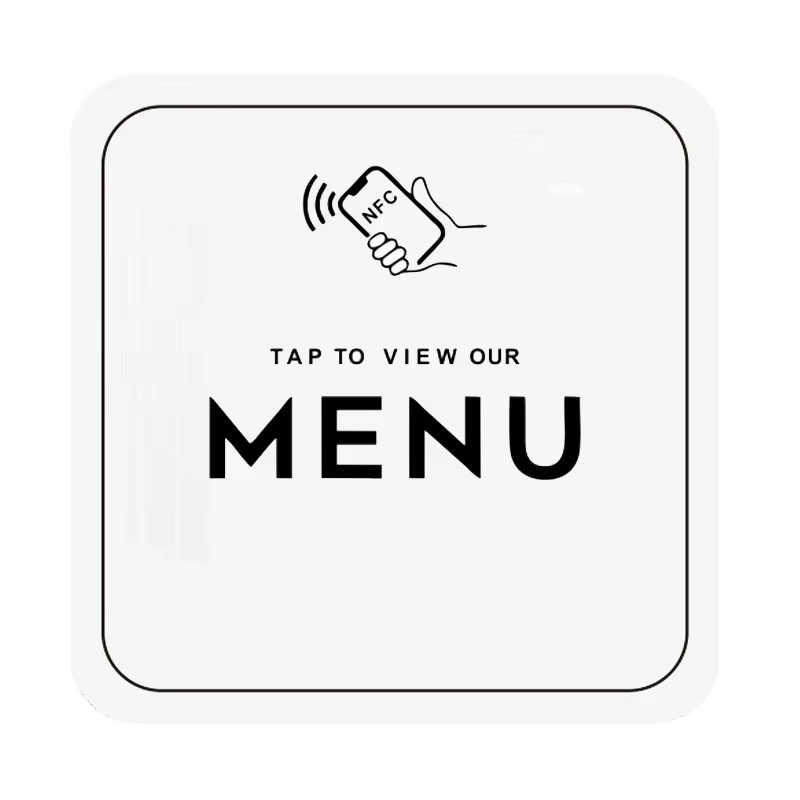
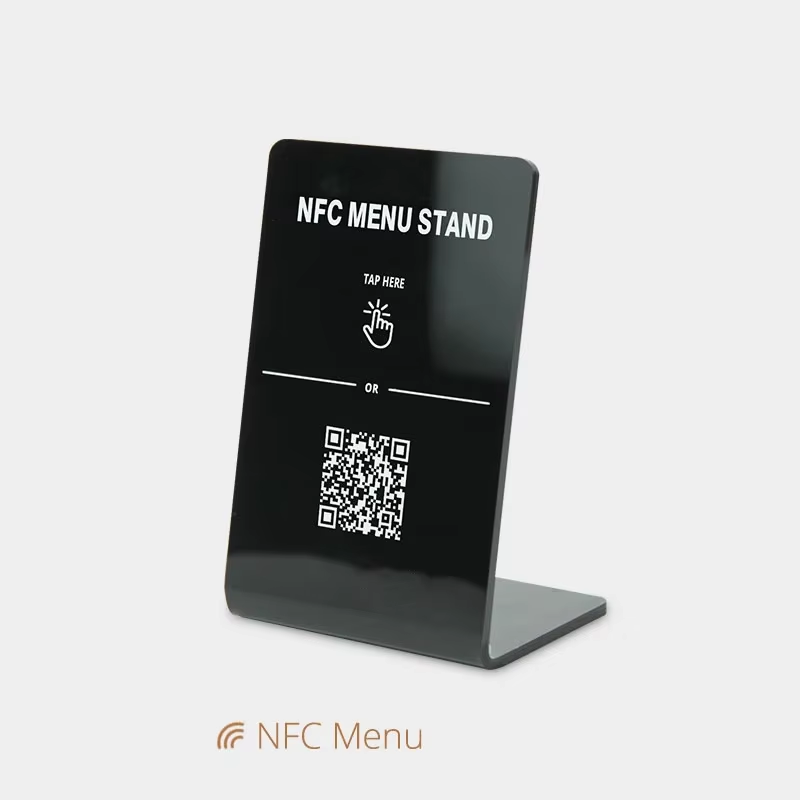
NFC Menus!
Yes as simple as it sounds! The NFC Menus in short are almost very similar to QR Code Menus. However, the advantages outweigh everything else!
To start with, they come in a wide variety of presentations including PVC cards, acrylic stands, coasters, table stickers, epoxy waterproof coated material, and many more.
NFC stands for Near Field of Contact. Products with NFC tags have been used for many years. As a matter of fact most of the clothing in western store include this form of tagging. Some NFC tags have very powerful chips that can be scanned from a long distance, when you try to walk out of the store with them, they may cause the store product alarm to ring until they are disabled.
Starting 2024 most people in Oman and GCC are already using this technology with their banks, some without realizing it.
Basically we have an installed chip which can be read as soon as your NFC enabled phone gets very close to it. By the way, almost any smart phone sold in the GCC market in the last 3 years for over $150 probably has this technology already inbuilt. Yes including the phones that most laborers use to make data based WiFi calls to thirdworld countries day in and day out.
This use of this technology is very similar to most people today using their phones to pay directly without touching the so called “WiFi” POS (Point of Sale) Terminals.
During Corona pandemics time (2020 to 2023), most people got used to whip out their cards and pay at “WiFi” enabled POS Terminals. It was called WiFi because people were aware of that term, if it was called NFC, it would have confused people. Prior to 2020, contactless payments were also made at most filling stations, but regular customers were not aware of this as their card was handled by the person filling the petrol for them.
When you pay at the POS using your phone, in essence your phone is doing reverse tag… where the POS Terminal reads your phone… but your phone already has the feature to do what the POS Terminal does, that is to read NFC devices. In the future you may even be able to transfer money between phones only using this feature, though for security, it may take time to handle this.
Therefore to interact with an NFC menu, all you have to do is whip out your phone and get it on from sleep mode, which requires you to quickly open it. Once your phone is active, you bring your “NFC reader” part of your phone to the NFC Chip (typically the part that has WiFi waves and/or says “tap here), and your phone pops up an option to open the link offered by the NFC programmed chip. In this case, we are talking about the menu.
If you do not know where your reader part is, simply slide (back part of) the phone around the NFC coded item and your phone will read the code.
Typically for iPhones, the reader is at the top of the phone and has ability to read from zero degree angle (0º) to ninety degree angle (90º), while Android & Windows phones have the reader about a third (1/3) way down from the top to a half (1/2) way down from the top of the phone, which means if you place the card or nfc item FLAT and right about the middle of the phone, it will read. Androids tend to have stronger readers (so far) compared to the iOS devices.
As eluded to earlier, the NFC chips are normally available embedded in cards, poster, sticker, menus, PVC cards, coasters, wooden plaques, epoxy waterproof coated material, or in acrylic plaques! In most cases, they are durable and easy to clean. They are normally more appealing and often they may have printed on them QR Code pointing to the same entity as the NFC chip.
We hope that is enough information to showcase the similarities and advantages of NFC chip enabled menus.
That is enough about NFC chips! Now let’s talk about what we offer here.
- Online Menus – basic and free for all restaurants (pdf, jpg, html, text or other standard formats), this helps reduce menu cost for most restaurants.
- Online Restaurant Listing – basic and free for all restaurants (location, contacts, etc.), getting your restaurant on the listing adds an extra digital foot print for your business and helps you get discovered more easily.
- NFC & QR Code Options – at nominal cost to all restaurants (can be linked to restaurant website menu if already exists).
- Advanced Updatable / Dynamic Menu – at nominal cost to all restaurants (for restaurants which do not have websites).
- Video Content for menus – at nominal cost to all restaurants (restaurants provides menu item videos no longer than 10 seconds per item, or we can offer a contact to help with this, restaurants have to pay the photo/video grapher)

